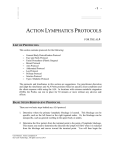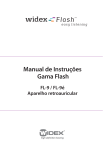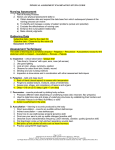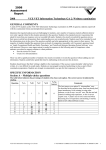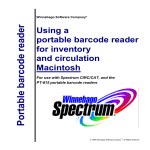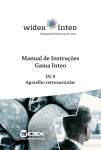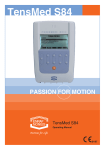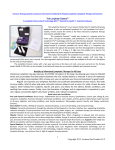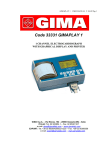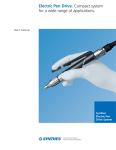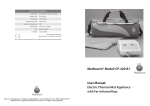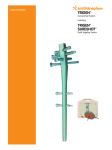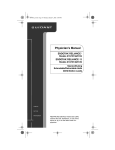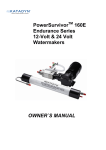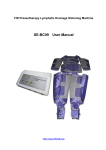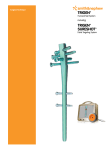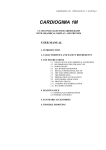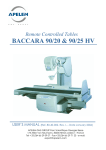Download action lymphatics protocols - Clean Your Lymph System, Light Beam
Transcript
.. .. .. .. .. -1 - ACTION LYMPHATICS PROTOCOLS FOR THE AL2 LIST OF PROTOCOLS This section contains protocols for the following: – – – – – – – – – – General Body Detoxification Protocol Face and Neck Protocol Facial Procedures (Plastic Surgery) Breast Protocol Arm Protocol Abdominal Protocol Leg Protocol Prostate Protocol Sciatica Protocol Type 2 Diabetic Protocol The protocols and timeframes in this section are suggestions. Use practitioner discretion and adapt the timeframes and AL2 Probe positions based on specific client conditions and the client response while using the AL2. In locations with extreme metabolic stagnation, you can rest the AL2 Probes in place for 30 minutes or more without any adverse side effects. BASIC STEPS BEHIND ANY PROTOCOL There are two basic steps behind any AL2 protocol: 1. Determine where the primary lymphatic blockage is located. This blockage can be specific, such as the left breast or the right inguinal nodes. Or, the blockage can be nonspecific, such as general swelling in the upper body or ankles. 2. Determine the flow pattern from the terminal point to the point of lymphatic blockage. This means you need to determine the direction the lymph will flow when it is released from the blockage and moves toward the terminal point. User Manual: Action Lymphatics 2 ELF Labs Technology. All rights reserved. 2013 .. .. .. .. .. -2 - You will then begin the protocol by starting at the proximal point and working back through the flow pattern towards the distal point. In other words, you will work “backwards” through the flow pattern from the subclavian terminal point to the point of congestion. (Refer to Section 2 to review the flow patterns.) SESSION TIMEFRAMES – LYMPH MODE Timeframe for a Typical Client Session A session timeframe of 60 minutes is good when working on an individual. This is the time it will take to properly address any issue residing within the anterior (frontal) portion of the body. If you are only dealing with the upper portion of the body (i.e. face, breast, arm, or wrist), the session can be as little as 30 minutes. However, 60 minutes is always a good standard to use for a complete session. If you are working on the posterior (back) portion of the body, you may want to add 15 – 30 minutes to the session. Allowing 90 minutes for a posterior session ensures that the session is not rushed and that you can provide sufficient detail to the work. Timeframe for a Single Point/Location A standard timeframe of ten minutes is good for covering a specific position along the flow pattern where there is probable congestion, such as the parasternals or the cisterna chyli. Accelerated Schedules There are some instances when you will want to provide an accelerated schedule for a client. In any acceleration, always have your client prepped by having them drink at least two quarts of water within eight hours prior to the start of the session. An accelerated program can take several forms: You can work on the client up to one hour on the anterior and one hour on the posterior in the morning and duplicate the process in the early evening. You can work on areas, sections, or quadrants of the body. For example, you may want to spend 60 minutes working on the arms or legs and/or the sciatica and/or the upper back, and duplicate the process in the early evening. User Manual: Action Lymphatics 2 ELF Labs Technology. All rights reserved. 2013 .. .. .. .. .. -3 - Allow one day of rest for every two days of accelerated work. In general, rest the body every third day. This provides the body time to process its fluid. LINEAR SWEEP MODE Practitioners have improved the results of their client sessions by using the AL2 in Linear Sweep Mode. Some practitioners use the Linear Sweep Mode for the entire session. Others find it beneficial to alternate between the two modes. A WORD OF CAUTION: It is very important to closely monitor your client the first few minutes you have them on the Linear Sweep Mode. Some clients detox too quickly and need to gradually transition into the Linear Sweep Mode from the Lymph Mode. Lymph Mode Linear Sweep Mode Main Frequencies: Full Range of Frequencies: Emits the three basic frequencies needed by the body for bacteria, viruses, and fungus. No two people are the same. Different people react differently to the same frequency. Therefore, when the entire range is presented, it accommodates everyone. Cycles through various frequencies from subsonic through to ultrasonic harmonics. Adds more harmonics than the standard frequencies. Creates a perfect, complete harmonically rich sweep, allowing every cell in the body to be electrically balanced and charged to full capacity and potential health. Cells can select the frequencies they need. If a frequency is not needed, it just passes through A NOTE ON PROTOCOL POSITIONS 1 AND 2 Because you will be working “backwards” through the flow pattern from the terminus to the point of inflammation, all protocols begin by placing the Probes on the subclavian points, the terminus for all lymphatic fluid as it re-enters the venous system. The subclavian points are labeled as Position 1 in all protocols. Position 2 (the trapezius muscles) is the acupressure point called Gallbladder 21 (GB21). Placing the Probes at GB21 assists the body in releasing excess tension and stress. These points also facilitate the flow of lymph fluid from the arm, neck, and head. User Manual: Action Lymphatics 2 ELF Labs Technology. All rights reserved. 2013 .. .. .. .. .. -4 - PROBE PLACEMENT SUMMARY AL Probes balance the polarity of the cell and move lymph debris out. 1.) Place the Probes on all drainage points, either upper or lower body, to break up and move material. 2.) Make sure the lymphatic flow points are all covered with the Probes so that material can flow out of the body as it is moved. 3.) In a difficult situation where there is a large blockage, place a Probe on the front of the body and another Probe on the back of the body for quicker movement. 4.) Always make sure the main drainage points of the body are cleared. During the first 10 minutes of treatment time, place Probes on the subclavian nodes to assure these points of drainage are open. 5.) For severe headache, start by placing Probes on the left and right subclavian nodes; then move the Probes to the left and right occipital nodes. If pain persists, place Probes over the eyes to allow trapped fluid to move away from the ocular area. If Infrared Therapy is being used, be sure the eyelids are kept closed or turn IR switch off. 6.) If there is a sinus problem, place Probes on left and right subclavian nodes; then move the Probes over the sinuses. 7.) For anti-aging effects and to make the face more defined and less bloated, place Probes on subclavian nodes; then on each cheek under the cheekbone; then on the jaw line; then to the sinus area just below the eyes. This will drain the fluid from the face and the person will have a more contoured and youthful appearance. 8.) Use the Lymph Mode when you are working on a disease. 9.) Use the Linear Sweep Mode when the body needs to boost the immune system. This will assist in reducing fatigue, which often occurs following a chemo or radiation session. 10.) Always follow the flow patterns of lymph as described in Section 2, The Flow Patterns of lymph. 11.) For keeping heads in place during treatment times, some practitioners have found that using leather book weights like the one pictured here is very useful. They are available at most book stores or online at Amazon.com GENERAL BODY PROTOCOL DETOXIFICATION User Manual: Action Lymphatics 2 ELF Labs Technology. All rights reserved. 2013 .. .. .. .. .. -5 - Overview As our body’s lymphatic system becomes more overburdened, we find ourselves accumulating more fluid and becoming more engorged with fluid. As a result, our waistlines, our physical structure, and our bodies become heavier with accumulated fluid. When we are able to move this fluid, we are able to recover our structure the way we looked when we were in our early teens or twenties. Tissue detoxification is an excellent way to move excess fluid from the body and assist in improving our immune system through increased function. General body detoxification is one way to mobilize the fluid, commence toxic elimination, and assist the body in re-establishing proper lymphatic function. SUGGESTED GENERAL BODY DETOXIFICATION PROTOCOL STEP 1: Place one Probe under left collarbone (1) and the other Probe under right collarbone (2). Hold the Probes in these areas for 3 to 5 minutes. If collarbone has EMS, hold Probes in position for 20 minutes. STEP 2: Place one Probe at left GB 21 (1A) and the other Probe at right GB 21 (2A) for 20 minutes. STEP 3: Place Probes on axillary nodes (1 and 2) for 5 minutes. STEP 4: Move Probes to sternum (3 and 4) for 5 to 10 minutes. STEP 5: Place both Probes to cistern chyli (5) side-by-side for 5 to 10 minutes. STEP 6: (a) Hold one Probe at cisterna chyli (5) and move other Probe to transverse colon (6) and hold for 5 to 10 minutes; then (b) move Probe from 5 to transverse colon (7) and hold for 5 to10 minutes; then (c) move Probe from 7 to descending colon (8) and hold for 5 to10 minutes; then (d) move Probes to inguinal nodes (9 and 11) and hold for 5 to10 minutes. STEP 7: Place one Probe at midpoint of superior pubic symphysis (R2) and the other Probe at front midline 2 thumb widths below umbilicus (R5) for 5 to 10 minutes. User Manual: Action Lymphatics 2 ELF Labs Technology. All rights reserved. 2013 .. .. .. .. .. -6 - STEP 8: Place one Probe at 5 and (a) move the other Probe to C1 and hold for 5 minutes, then (b) move one Probe to C2 and keep one Probe on 5 and hold for 5 to 10 minutes. STEP 9: Hold one Probe at 5 and move second Probe to 1 and hold for 5 minutes. NOTE: Timeframes and protocols are suggestions. Use practitioner discretion and adapt timeframes and protocols to specific client conditions and his/her response to treatment. Probe times in locations with extreme metabolic stagnation (EMS) can rest in place for 30 minutes or more without any adverse side effects. FACE AND NECK PROTOCOL Overview The past few years has seen a growth in laser and pulsed light treatments, microdermabrasion, peels, and potions – all in the name of cell turnover, but our equipment User Manual: Action Lymphatics 2 ELF Labs Technology. All rights reserved. 2013 .. .. .. .. .. -7 - and technology is separate from the rogue faction of skin specialists who prolong the harmful effects of repeatedly removing layers of skin. Our system rehabilitates skin cells through the stimulation of lymph drainage which is a factor in the anti-aging process. When lymph nodes become blocked, the flow of lymph is impaired and the body is unable to rid itself of waste material depriving cells of oxygen and nutrients. This can set the stage for a host of diseases, including acne which can become severe enough to be a traumatic experience for anyone who suffers from it both physically and emotionally. Many imbalances can cause swollen, dull, blemished, or sagging skin. Using the Face and Neck Protocol, along with good nutrition, physical fitness, proper skin care, vitamins and supplements can lead to a radiant complexion. SUGGESTED PROTOCOL FOR FACE / NECK AREA STEP 1: Place one Probe under left collarbone (1), and the other Probe under right collarbone (1). Allow Probes to rest in these areas for 3 to 5 minutes. If there is EMS, let Probes rest on 1 for 10 to 15 minutes. STEP 2: Place one Probe on left GB 21 (2) and the other Probe on right GB 21 (2) for 20 minutes. STEP 3: Work both Probes on area 3 for 5 minutes. Use longer if EMS is present. STEP 4: Hold both Probes on subparotid nodes (4) for a minimum of 5 to 10 minutes. Hold the Probes longer (20 minutes) if there is an inflamed tooth or if there is EMS. STEP 5: Move Probes from area 4 to 5 for a minimum of 5 minutes. Hold on any point that is sore or inflamed for up to 10 minutes. STEP 6: Move Probes from 4 subparotid (7) for a period of 5 minutes. Use longer if EMS is present. STEP 7: Move Probes to preauricular nodes (6) for 5 minutes. Use longer if EMS is present. User Manual: Action Lymphatics 2 ELF Labs Technology. All rights reserved. 2013 .. .. .. .. .. -8 - STEP 8: Move Probes underneath eyes (8) for 5 minutes, then move Probes to post auricular nodes (9) for a minimum of 5 minutes. Use longer if EMS is present. STEP 9: Place Probes on neck at internal jugular chain and jugolodigastric nodes (10 to 11) to address EMS in the neck. Work these areas for a minimum of 5 to 10 minutes. STEP 10: Move Probes to occipital nodes (12) for 5 to 10 minutes. Hold longer if EMS is present. STEP 11: Conclusive move. Move Probes to point 2 for 5 minutes. Then move Probes to point 1 for 5 minutes. IMPORTANT: When using Infrared Therapy for the eyes, keep eyelids closed or turn IR switch off. SUGGESTED PROTOCOL FOR TEETH AND JAW AREA STEP 1: Place one Probe over the terminus point (A). Move it back and forth very slowly - about four inches, left to right, over this area. Hold for 2 to 3 minutes. STEP 2: From the collar bone (B), move the Probe in an upward direction until you meet the jaw. Slowly cover the jaw area (B). Hold for 2 to 3 minutes. STEP 3: Move the Probe along the underside of the jaw (C), from left to right, for about 2 to 3 minutes. Leave it on longer if you locate the pain area. Next, move the Probe along the top of the jaw (D), slowly covering the area. If the tooth pain is located in Point D, you may wish to hold the Probe over the pain area for up to 5 minutes. Hold for 2 to 3 minutes. STEP 4: Hold the Probe over Point E, slowly moving it in a circular motion. Hold in this area 3 minutes or longer. If it feels good, let it stay on this location for 5 to 6 minutes. User Manual: Action Lymphatics 2 ELF Labs Technology. All rights reserved. 2013 .. .. .. .. .. -9 - STEP 5: Hold the Probe over Point F, slowly moving it in a circular motion. Hold in this area 3 minutes or longer. If it feels good, let it stay on this location for 5 to 6 minutes. STEP 6: Hold the Probe over Point G, slowly moving it in a circular motion. Hold in this area 3 minutes or longer. If it feels good, let it stay on this location for 5 to 6 minutes. STEP 7: REPEAT. You may repeat in the reverse by placing the Probes on Point G, Point F; Point E; Point D; Point C; Point B; and finally Point A. Hold for 2 minutes at each point. FACIAL PROCEDURES (PLASTIC SURGERY) Note: For best results, this protocol is most effective when used with the ST-8 Oxygen Detoxification System. If you do not have the use of one, this protocol can be used with the AL2. User Manual: Action Lymphatics 2 ELF Labs Technology. All rights reserved. 2013 .. .. .. .. .. - 10 - One of the many offerings of a plastic surgeon includes surgical procedures for the face to include the forehead, eyelid, mid-facial and lower facial areas. Surgeons may perform one procedure or a combination of surgical procedures for their patients to accomplish best results. While each of these facial areas involves various surgical procedures, for the most part, the pre- and post- surgical Oxygen Detoxification System protocol will vary slightly from surgical procedure to surgical procedure. The use of the AL2 with this protocol will help for the most part and will produce certain results. These protocols may need to be adjusted to accommodate the situation where the surgeon has combined several surgical procedures. Specific areas where facial surgery is performed is identified within the areas marked below with letters representing each surgical facial area. We have included nose adjustment (i.e., rhinoplasty) as some surgeons may include this procedure and may be considered a repair of a congenital defect or a cosmetic adjustment. These facial areas are identified as: A - forehead area (involved procedure); B – eyelids (simple procedure); C – mid facial (simple procedure); D&E - lower facial (involved procedure); and F - nose adjustment (i.e., rhinoplasty) as each of the above surgical procedures may impact additional lymphatic pathways. PROTOCOL APPLIES TO ALL PRE- AND POST-SURGICAL PROCEDURES (see Face Protocol for technical positioning of Probes). Step 1: Apply one Probe to left GB21 and one Probe to right GB21 for 15 minutes. Step 2: Apply one Probe to left subclavian and one Probe to right subclavian for 15 minutes. Step 3: Apply one Probe to left cervical node and one Probe to right cervical node for 15 minutes. Once the above protocol is performed, proceed with the following protocols as they relate to the face area surgical procedure. A - FOREHEAD (involved): (a) First Step: Apply one Probe to left preauricular (parotid) node and one Probe to right preauricular (parotid) for 15 minutes; (b) Second Step: Apply one Probe to left submandibular (submaxillary) node and one User Manual: Action Lymphatics 2 ELF Labs Technology. All rights reserved. 2013 .. .. .. .. .. - 11 - Probe to right submandibular (submaxillary) for 15 minutes; (c) Third Step: Apply one Probe to left forehead section at the coronal suture or the endoscopic incision site and one Probe to right forehead section at the coronal suture or the endoscopic incision site for 15 minutes. B – EYELID (simple): (a) First Step: Apply one Probe to left preauricular (parotid) node and one Probe to right preauricular (parotid) node for 15 minutes; (b) Second Step: Apply one Probe each to left and right eyes for 15 minutes. Keep eyelids closed if using Infrared Therapy or turn IR switch off. C – MID FACIAL (involved): (a) First Step: Apply one Probe to the left hairline incision point where the endoscopy was inserted and one Probe to the right hairline incision point where the endoscopy was inserted for 15 minutes; (b) Second Step: Apply one Probe to left submandibular (under chin) node and one Probe to right submandibular (under chin) node for 15 minutes. D/E – LOWER FACIAL (simple): (a) First Step: Apply one Probe to left preauricular (parotid) node and one Probe to right preauricular (parotid) node for 15 minutes; (b) Second Step: Apply one Probe each to the postauricular (retroauricular/occipital) nodes for 15 minutes. F – NOSE ADJUSTMENT / RHINOPLASTY (minor): (a) First Step: Apply one Probe to the left side of the nose and one Probe to the right side of the nose for 15 minutes; (b) Second Step: Apply two Probes to the retro-pharangeal (retroauricular/occipital) nodes for 15 minutes; (c) Third Step: Apply one Probe each to left and right cervical (neck) nodes for 15 minutes. SESSION COMMENTS: Pre-Surgical Sessions can be performed (a) when the patient returns for their pre-surgery conference; and, (b) 30 plus minutes prior to surgery. Post Surgical Sessions can commence (a) immediately following surgical procedure following patient compression or bandaging; and, (b) for the following surgical face area procedure timeframes and frequency of therapy as follows: (i) A - Forehead Surgery (1-3 HR surgery): we suggest one forty-five minute session 3 times per week for Week 1 to assist in reducing bruising and swelling. And, User Manual: Action Lymphatics 2 ELF Labs Technology. All rights reserved. 2013 .. .. .. .. .. - 12 - one forty-five minute session 2 times per week for Weeks 2 to 4. For preventive and improved healing, we recommend from Weeks 5 to 8, a forty-five minute session once a week. (ii) B - Eyelid Surgery (1–2 HR surgery): we suggest one thirty minute session 3 times per week for Weeks 1 and 2 to assist in reducing swelling and bruising. And, one thirty minute session 2 times per week for Weeks 2 to 3. For preventive and improved healing, we recommend for Week 4 - and after - a thirty minute session once a week until healed. Be sure to keep eyelids closed if using Infrared Therapy or turn IR switch off. (iii) C - Mid Face Surgery: (1–1.5 HR surgery): we suggest one thirty minute session 3 times per week for Weeks 1 and 2 to assist in reducing swelling and bruising. And, one thirty minute session 2 times per week for Weeks 3 and 4. For preventive and improved healing, we recommend for Weeks 4 to 9, a thirty minute session once a week until healed. (iv) D/E - Lower Face Surgery (3 HR surgery): we suggest one thirty minute session 3 times per week for Weeks 1 and 2 to assist in reducing swelling and bruising. And, one thirty-minute session 3 times per week for Weeks 3 and 4. For preventive and improved healing, we recommend for Weeks 5 to 10, a thirty-minute session once a week until healed. (v) F – Nose Adjustment (Rhinoplasty): This surgery bruises eyes quickly. If patient wishes to significantly reduce the possibility of bruising, we suggest one forty-five minute session 5 times per week for Week 1. And, one forty-five minute session 3 times per week for Weeks 2 and 3. For preventive and improved healing, we recommend for Weeks 4 to 6, a forty-five minute session once a week until healed. THERAPY NOTE: Depending on their pre-surgical condition (i.e., are they slim, moderately heavy, or very heavy) and whether the physician combines more than one surgical procedure, the client’s protocol times and frequencies may need to be adjusted. For example, for slim patients, the recommended pre- and post- surgery session time frames and frequencies above should bring quick results for the patient. However, for a heavier patient or a patient with more involved lymphatic obstruction, we recommend extended time frames and frequencies by 50% to 100%. As soon as User Manual: Action Lymphatics 2 ELF Labs Technology. All rights reserved. 2013 .. .. .. .. .. - 13 - you hear the patient’s own story about how they are feeling, how their healing is working, and what you see (the swelling or bruising is less or not reducing) you will know if you need to increase the time and frequency of the protocols. LET THE PATIENT BE YOUR GUIDE. BREAST PROTOCOL Overview The typical progression for breast inflammation commences with lymph stasis occurring initially at the subclavian (apical axillary) nodes; and, as fluid accumulates, edema increases. The inflammation follows a path leading towards the brachial and User Manual: Action Lymphatics 2 ELF Labs Technology. All rights reserved. 2013 .. .. .. .. .. - 14 - subscapular axillary nodes, extending towards the pectoral nodes resulting in increased fluid retention initially within the breast’s lateral quadrant and then spreading to the full breast. In some cases, fluid blockage progresses from the subclavian (apical axillary) towards the parasternal (internal thoracic) nodes, into the medial upper quadrant resulting in an increase of fluid. Oftentimes, both conditions have occurred by the time a woman or man visits his/her doctor because they have noticed the fibrosis in the tissue or the pain level has increased to an unbearable level. In either case, tenderness is always indicated as the inflammation progresses from the subclavian towards the breast. Physical constriction such as wearing a tight fitting bra can cause excess fluid to accumulate within the breast. EMS can occur. This provides an opportunistic event for the growth of a fibrotic or cancerous condition. In every case of inflamed or cancerous breasts, lymphography captures the extensive involvement of the lymph nodes, especially within the axillary and pectoral lymph node group. Standard Flow Pattern of Breast Lymph Fluid The thoracic cavity is dimensional and passes fluid superficially and through a deep lymphatic network using both anastamosis and alternative lymph pathways. In the breast, the fluid passes to the other breast by way of the parasternals and alternative pathways, which can occur by way of the cisterna chyli. Specifically, in the lateral quadrant – 75% to 80% of breast lymph flows to the axillary nodes; in the medial upper quadrant – 20% to 25% of the breast lymph fluid drains parasternal, to the opposite breast, or to anterior mediastinal nodes; the medial lower quadrant drains deeply to the abdominal (phrenic) nodes or the cisterna chyli; the nipple drains to all four quadrants SUGGESTED PROTOCOL FOR INFLAMED BREAST STEP 1: Place one Probe under left collarbone (1), and the other Probe under right collarbone (2). Allow Probes to rest in these areas 3 to 5 min. If User Manual: Action Lymphatics 2 ELF Labs Technology. All rights reserved. 2013 .. .. .. .. .. - 15 - there is extreme metabolic stagnation (EMS), let Probes rest in 1 & 2 for 10 to 15 min. First Session. STEP 2: Place one Probe on left GB-21 (1A) and the other Probe on right GB-21 (2A) for 20 min. STEP 3: Place one Probe on left collarbone (1) and the other Probe on right collarbone (2) for 2 min. STEP 4: Left Breast: (a) While holding one Probe on left collarbone (1), place second Probe on central axillary node (1B) for 5 to 20 minutes; then move first Probe to pectoral node (1C) and second Probe to mammary node (1D) for 5 to 20 min. STEP 5: Left Breast: Hold one Probe on left collarbone (1) and place the other Probe on sternum (3 to 4) for 5 to 20 minutes. STEP 6: Left Breast: Hold one Probe on parasternal (midway between 3 & 4) and the other Probe on cisterna chyli (5) for 5 to 20 minutes. STEP 7: Left Breast: Hold one Probe on left collarbone (1) and the other Probe on axillary (1B) for 5 minutes. STEP 8: Right Breast: Follow left breast steps 4 to 7 but use 2, 2B, 2C, 2D. NOTE: Time frames are suggestions. Use practitioner discretion and adapt time frames to specific patient condition and response to treatment. AL2 Probe times in locations with EMS can rest in place for 30 minutes or more without any adverse side effects. ARM PROTOCOL Overview There are numerous issues contributing to edema, and some of the more common reasons are due to surgical intervention, physical or sports injuries, physical work habits, personal garment constriction, and toxic reactions to the work or home environment. User Manual: Action Lymphatics 2 ELF Labs Technology. All rights reserved. 2013 .. .. .. .. .. - 16 - In every case, the chain of lymph nodes, commencing from the subclavian to the axillary to the deltopectoral and cubital nodes, are suspect in contributors to the blockage. Perhaps contributing the most commonly seen side effects of constriction within the above node structure is carpel tunnel and inflamed breast. A contributor to arm edema on the left side can also be tracked to lymph congestion within the trapezium muscle and breast. This muscle constriction contributes by placing the scalene muscle in tension or traction, resulting in the scalene pulling-up on the first and second rib causing potential for compression of the thoracic duct. Since the thoracic duct collects most of the fluid from the rest of the body, this constriction can contribute to additional fluid retention, which can increase the axillary node fluid processing workload and compromise lymph flow from the arm. The breast fluid additionally could place a contention for axillary node flow and also disrupt or impede the flow of fluid from the arm. When arm edema is relegated to a patient’s right side, the cause of edema would have all of the potential attributes contributing to fluid retention found in the left side edema, in addition to having to contend with fluid draining from the head. Since the head primarily drains to the right subclavian, all excess fluid draining from the sinus also adds to the load of the subclavians, which can compromise the natural flow of fluid from the arm. The issues contributing to arm edema are complex and influenced by many other fluid processing requirements, which must be addressed prior to re-establishing and sustaining normal fluid flow from the arm SUGGESTED PROTOCOL FOR ARM EDEMA STEP 1: Place one Probe on left collarbone (1) and the other Probe on right collarbone (2). Allow Probes to rest in these areas a minimum of 3 to 5 minutes. If collarbone is not defined (extreme metabolic stagnation User Manual: Action Lymphatics 2 ELF Labs Technology. All rights reserved. 2013 .. .. .. .. .. - 17 - [EMS] under the skin), let Probes rest in 1 and 2 for 10 to 15 minutes. STEP 2: Place one Probe on right GB 21 (2) and the other Probe on left GB 21 for 20 minutes. STEP 3: Place one Probe on left collarbone (1) and the other Probe on right collarbone (2) for 1 minute. STEP 4: Right Arm Edema: Place one Probe on left collarbone (1) and the other Probe on deltopectoral node (3) for 5 minutes. If EMS is present, leave in position for 20 minutes. STEP 5: Right Arm Edema: Keep one Probe on 1 and the other Probe on axillary node group (armpit) (4) for 5 minutes. If EMS is present, leave in position for 20 min. STEP 6: Right Arm Edema: If there is contention with pectoral nodes (nodes are hard), then place one Probe on axillary node group (armpit) (4) and the other Probe on pectoral node (5) for 5 minutes. If EMS is present, leave in position for 20 min. STEP 7: Right Arm Edema: Keep one Probe on axillary node group (4) and place the other Probe on cubital/supratrochlear nodes (6) for 5 minutes. If EMS is present, leave in position 20 min. STEP 8: Right Arm Edema: Sometimes you will notice lymph stagnation at 7. In this case, keep one Probe on 6 and place the other Probe on 7 for 5 minutes. STEP 9: For Left Arm Edema: Follow STEP 4 to STEP 8 for left side. NOTE 1: Superficial lymphatic vessels arise from lymphatic plexuses in the digits, palm and dorsum of hand and ascend mostly with superficial veins such as the chepalic and basilic veins. Most of the material associated with these veins will travel to the cubital or to efferents in the axillary node group. In severe upper arm problems, it may take additional lymph massage of upper arm to encourage material to flow. However, if the axillary node groups have been cleared previously of blocked material, the movement of the fluid from the upper arm should be more easily accomplished. NOTE 2: Sometimes, it is necessary to place Probes on B-36, B-38 and SI-10 as an add-on after STEP 1 to assist in breaking up additional metabolic stagnation in the shoulder. User Manual: Action Lymphatics 2 ELF Labs Technology. All rights reserved. 2013 .. .. .. .. .. - 18 - ABDOMINAL PROTOCOL Overview The abdominal area contains the majority of the internal organs including: Organs related to digestion - the stomach, the end of the esophagus, the small and large intestines, the liver, the gallbladder, and the pancreas. The aorta - a large blood vessel that runs straight down the inside of the abdomen. The appendix - an organ in the lower right abdomen whose function is not well understood. The kidneys - two bean-shaped organs that lie deep within the abdominal cavity. User Manual: Action Lymphatics 2 ELF Labs Technology. All rights reserved. 2013 .. .. .. .. .. - 19 - Within these many organs, inflammatory-causing pain and discomfort can occur. Most of the abdominal organs integrate with the thoracic duct through lymphatic capillaries and collectors. Plasma fluid and protein are processed from the area surrounding the organ’s cells and are returned to the circulatory system via the thoracic duct’s integration into the venous angles. Any obstruction within the abdominal area, whether natural, genetic, or induced by surgical, physical or emotional trauma, can adversely affect transport capacity to and through this major lymphatic pathway. Obstruction can lead to accumulation of fluid within an organ’s interstitial spaces promoting both acute and chronic inflammation. Common Lymphatic Issues Common, but non-critical, manifestations of potential abdominal lymphatic structure blockage can include: slow to rapid weight gain due to prior surgical intervention, pregnancies, or tumor growth; constipation due to dehydration of interstitial spaces and mucous membrane; diarrhea and vomiting (gastroenteritis) due to poor lymphatic drainage and immune system support issues; eating too much spicy or greasy food due to an allergy or “bad” food; or having an infection (urinary, bladder, etc.) that initiates cytokine signaling for inflammatory processes. Other lymphatic obstruction issues that can contribute to the symptoms and require medical treatment can include: excessive gas; chronic constipation; lactose intolerance (milk intolerance); viral gastroenteritis (stomach flu); irritable bowel syndrome (sensitive stomach with intermittent episodes of diarrhea and constipation); heartburn or indigestion; gastro esophageal reflux; ulcers; cholecystitis (inflammation of the gallbladder) with or without gallstones; appendicitis (inflammation of the appendix); diverticular disease, including inflammation of small pouches that form in the large intestines (diverticulitis); bowel obstruction -- in addition to pain, this causes nausea, bloating, vomiting, and inability to pass gas or stool; urinary tract infections; pancreatitis (inflammation of the pancreas); crohn's disease or ulcerative colitis (different types of inflammatory bowel disease); and menstrual cramping; endometriosis; and uterine fibroids. In each of these instances, one of the key recovery issues the body must initiate is to re-establish relevant lymphatic pathways. These blocked pathways, including lymphatic capillaries, collectors, and ducts, are responsible for transporting excess fluid and interstitial particulates such as protein, fats, cellular debris, toxins, white blood cells, red blood cells, etc. away from the organ’s interstitial spaces. Without the opening or re-establishment of these pathways, symptom reduction is less likely to occur. User Manual: Action Lymphatics 2 ELF Labs Technology. All rights reserved. 2013 .. .. .. .. .. - 20 - Self-Help Strategy In addition to addressing re-establishment of blocked lymphatic pathways, some home remedies, considered acceptable standard medical care for non-critical abdominal pain, include sipping water or other clear fluids and avoiding solid food for the first few hours. If there has been vomiting, wait six hours. Then, eat small amounts of mild foods. If the pain is high up in the abdomen and occurs after meals, antacids may provide some relief, especially if there is heartburn or indigestion. Avoid citrus, high-fat foods, fried or greasy foods, tomato products, caffeine, alcohol, and carbonated beverages. Avoid aspirin, ibuprofen, and narcotic pain medications unless a health care provider prescribes them. Even for other-the-counter medications, it is always best to consult a physician or health care provider prior to use. Protocol Strategy The Abdominal Protocol is provided to help reduce excess interstitial fluid and particulate accumulation. This is done by expediting movement of lymphatic fluid, resulting in the ease of pressure on the peritoneum and nerves – a possible contributing factor to the previously described discomforts. The strategy of the Abdominal Protocol is to open superior lymphatic efferent pathways, so the inflamed areas can commence lymphatic fluid flow and result in reduction of fluid accumulating within the interstitial spaces. Open the terminus and whole body tension points to reduce some of the physical stress within the pertinent musculature and lymphatic pathways to provide for the most efficient opportunity for lymphatic fluid movement and transport. These areas include the thoracic duct terminating location within the supra-clavicular fossa; the trapezes muscle; the sternum and its xipoid process; the cisterna chyli; and the colon and intestinal issues which may be inflamed and retaining lymphatic fluid adding to edema and pain. SUGGESTED PROTOCOL FOR ABDOMINAL AREA STEP 1: Place both Probes on the left and right subclavian/collarbone (1) for 10 minutes. If collarbone presents extreme metabolic stagnation, let both Probes rest on 1 for 20 minutes. STEP 2: Place Probes on left and right GB-21 (2) a minimum of 20 minutes. User Manual: Action Lymphatics 2 ELF Labs Technology. All rights reserved. 2013 .. .. .. .. .. - 21 - STEP 3: Place Probes on parasternals (3 & 4) for 5 to10 minutes. STEP 4: Place both Probes side-by-side on cisterna chyli (5) located approximately 3 fingers above umbilicus for a minimum of 10 minutes. If stomach is feeling full, use for an additional 10 minutes. STEP 5: Place both Probes on the left and right 6 locations for 10 to 20 minutes, depending upon client need. This position helps address lymphatic issues involving the transverse colon and small intestines. STEP 6: Place both Probes on the left and right 7 locations for 10 to 20 minutes depending upon client need. This position helps address lymphatic issues involving the descending colon and small intestines. STEP 7: Place both Probes on left and right 8 locations for 10 to 20 minutes. This helps address lymphatic issues involving the intestines and lower portion of ascending colon. STEP 8: Place Probes at both 9 locations for up to 20 minutes. This position helps address lymphatic issues involving the sigmoid colon. STEP 9: Redo STEP 1 for 10 minutes. NOTE: These timeframes are suggestions. Use practitioner discretion and adapt the timeframes to specific client conditions and his/her response to treatment. In cases of EMS you can leave the Probes in place for 30 or more minutes without any adverse side effects. User Manual: Action Lymphatics 2 ELF Labs Technology. All rights reserved. 2013 .. .. .. .. .. - 22 - LEG PROTOCOL Overview When starting this protocol, it is important to remember that all lower abdominal fluid generally follows the path of fluid movement from the toes to the nose. So, it is most important to open the subclavian, parasternals, cisterna chyli and the iliac nodes prior to working on the lower leg. As people age, more toxins and water are accumulated in the lymph system until one day they wake up bloated, engorged, and looking like an inflated balloon. This is lymph stress. Even if one is trim and slim, nasty cellulite and sticky harmful toxins accumulate in the lymph and can cause water to build up like a dam in a river – most often settling in the legs. The Leg Protocol was developed to help move the heavy build-up of water and putrid waste material from the lower body. User Manual: Action Lymphatics 2 ELF Labs Technology. All rights reserved. 2013 .. .. .. .. .. - 23 - SUGGESTED PROTOCOL FOR LEG STEP 1: Once you have completed opening the receiving nodes, then place one Probe on the superior inguinal node and the other Probe on the inferior inguinal node (2). Leave in this area for a minimum of 5 to 10 minutes, depending on the level of extreme metabolic stagnation. STEP 2: Place one Probe on left inguinal node (3) and place the second Probe on the popliteal node (4). Leave in place for 10 minutes, depending on the amount of EMS. STEP 3: While holding one Probe on 4, move the second Probe along the great saphenous vein to the ankle (5). On the lateral side, one often finds EMS along the fibula; therefore, work this area from the knee to ankle. STEP 4: Hold one Probe on 6 and move the second Probe along 7 and 8. Keep the Probes in this area for a minimum of 5 to 10 minutes, depending on the extent of EMS. If one finds EMS at the phalanges (toes) on the sole of the foot, then leave on the phalanges for a minimum of 5 to 10 minutes. STEP 5: You have completed the protocol for the left leg. Now, proceed with the same protocol for the right leg. NOTE: Oftentimes, only one of the legs will be swollen or only the ankle will be swollen. In these instances, adopt the protocol to concentrate where you find the most amount of edema or swelling or EMS. User Manual: Action Lymphatics 2 ELF Labs Technology. All rights reserved. 2013 .. .. .. .. .. - 24 - PROSTATE PROTOCOL Overview The most common contributor to issues with the prostate is lymph stasis. The physical observation regarding contributing factors are poor definition of the collar bone, excess fluid in upper thoracic area, a “pot” or “distended” belly, pain in the inguinal nodes, and, in some instances, sciatic pain. The prostate drains to the inguinal and the iliac nodes. When there is excessive fluid upstream (i.e, in the iliac nodes, cisterna chili, parasternals or subclavian nodes), the fluid from the prostate is blocked from movement. This can contribute to the build-up of excess protein and hormone metabolic by products in the prostate leading to lymph fluid stagnation and pressure on the bladder. In many instances, tissue detoxification can provide an increased flow in this fluid and help release some of the pressure on the bladder and reduce the need for frequent urination. The detoxification strategy will be to assist material to move from the common point of obstruction along the prostate’s efferent pathway. This should include, as a minimum, the following: User Manual: Action Lymphatics 2 ELF Labs Technology. All rights reserved. 2013 .. .. .. .. .. - 25 - Clear the terminus – the point where the lymphatic fluid from the upper thoracic area re-circulates back into the body. Clear the cisterna chili, as it is a very critical point. It is the largest lymph vessel and is a main collecting point for much of the fluid within the thoracic area. Obstruction within this area is a primary contributor to the inability of fluid to move from the prostate. Clear the iliac and inguinals and then flood the prostate with photons. Obstruction of fluid flow in these areas is usually a secondary contributor (after the cisterna chili) to fluid accumulation within the prostate. Clearing these areas assists the prostate in releasing excess fluid and reducing pressure on the bladder. SUGGESTED PROTOCOL FOR INFLAMED PROSTATE STEP 1: Place one Probe on left subclavian/collarbone (1) and the other Probe on right subclavian/collarbone (2). Allow Probes to rest in these areas 3 to 5 minutes. If collarbone presents EMS, let Probes rest in 1 and 2 up to 20 minutes. STEP 2: Place one Probe on left GB- 21 (1A) and the other Probe on right GB- 21 (2A) for 20 minutes. STEP 3: Place one Probe at 1 and the other Probe at 2 for 1 minute. STEP 4: Place one Probe at 1 and move second Probe along sternum (3 to 4) for 5 to 10 minutes. STEP 5: While holding one Probe at 5: (a) move second Probe along transverse colon (5-6) for 5 to10 minutes; (b) move same Probe along transverse colon (5-7) for 5 to10 minutes; (c) move same Probe from cisterna chyli (5) and follow common iliac vessels (5- 8) for 5 to10 minutes; (d) move same Probe from umbilicus (8) inferiorly along C1 to right inguinal (12-13) for 5 to 10 minutes; (e) move same Probe from umbilicus (8) inferiorly along C2 to right inguinal path, following common iliac vessels for 5 to 10 minutes; (f) move same Probe from left superior inguinal (10) to left inferior inguinal path (11) for 10 to 20 minutes; (g) move same Probe along right superior inguinal path (12) to inferior inguinal path (13) for 10 to 20 minutes; (h) place same Probe on superior pubic symphysis superficial to prostate gland (9) and User Manual: Action Lymphatics 2 ELF Labs Technology. All rights reserved. 2013 .. .. .. .. .. - 26 - move Probe at cisterna chyli (5) to perineum - between scrotum and anus (14) and hold for 20 minutes. STEP 6: While holding one Probe on superior pubic symphysis superficial to prostate gland (9), (a) move second Probe from perineum (14) to umbilicus (8) and hold for 1 minute, (b) then move second Probe from umbilicus (8) to cisterna chyli (5) for 1 minute. STEP 7: While holding one Probe at cisterna chyli (5), move second Probe along sternum (from 5 to 4 to 3 to 1) for 2 minutes. NOTE: Time frames and protocols are suggestions. Use practitioner discretion and adapt time frames and protocols to specific patient condition and response to treatment. Probe times in locations with EMS can rest in place for 30 minutes or more without any adverse side effects. SCIATICA PROTOCOL Overview The key to successful treatment of the sciatica is to understand contributing causes and location of the blockages. There are numerous issues contributing to the edema, and some of the more common reasons are due to surgical intervention, physical or sport injuries, physical work habits, personal garment constriction, and/or toxic reactions to the work or home environment. In the Pelvis, at L4, L5, and C1, there is a sacral plexus (group) of lumbar, sacral, and coccygeal nerves, which travel from the spine, entering into the greater sciatic foramen, traveling down the medial side of the femur and then separating out the sciatic nerve. When fluid accumulates within this area (L4, L5 to C1.), it often leads to an uncomfortable sciatic pain. Providing for the fluid to move from this area and return to the anterior side of the body often results in immediate reduction of sciatic pain by at least 50%. User Manual: Action Lymphatics 2 ELF Labs Technology. All rights reserved. 2013 .. .. .. .. .. - 27 - The strategy for sciatic pain relief is to increase the free flow of fluid from all receiving nodes in the fluid processing chain that supports fluid release from this area. SUGGESTED PROTOCOL FOR SCIATIC PAIN ANTERIOR STEP 1: Place one Probe on left subclavian (1) and the other Probe on right subclavian (2). Allow Probes to rest in these areas 3 to 5 minutes. If collarbone has EMS, let Probes rest in 1 and 2 up to 20 minutes. ANTERIOR STEP 2: Place one Probe on left GB21 (1A) and the other Probe on right GB- 21 (2A) for 20 minutes. ANTERIOR STEP 3: Place one Probe at 1 and the other Probe at 2 for 1 minute. ANTERIOR STEP 4: Place one Probe at 1and move the second Probe along sternum (3-4) for 5 to 10 minutes. ANTERIOR STEP 5: Hold one Probe at cisterna chyli (5). (a) move second Probe along transverse colon (5-6) for 5 to 10 minutes; (b) move same Probe along transverse colon (5-7) for 5 to10 minutes; (c) move same Probe from 5 to 8 following common iliac vessels for 5 to 10 minutes; (d) move same Probe from umbilicus (8) inferiorly along iliac vessels (C1) to right inguinal point (12 - 13) for 5 to 10 minutes; (e) move same Probe from umbilicus (8) inferiorly along iliac vessels (C2) at (10 -11) for 5 to 10 minutes; (f) move same Probe from left superior inguinal (10) to left inferior inguinal path (11) for 10 to 20 minutes; (g) move same Probe along right superior inguinal path (12) to inferior inguinal path (13) for 10 to 20 minutes. ANTERIOR STEP 6: Hold one Probe at superior left inguinal node (10) and move second Probe from 10 to 14 to 15 for a period of 5 to 10 minutes. POSTERIOR STEP 1: Hold one Probe at right superior inguinal node (12) and move second Probe from 12 to 16 to 15 for a period of 5 to 10 minutes. POSTERIOR STEP 2: Hold one Probe on left center of 15 and the other Probe on right center of 15. Move User Manual: Action Lymphatics 2 ELF Labs Technology. All rights reserved. 2013 .. .. .. .. .. - 28 - both Probes inferiorly approximately L4/L5 to S1/S2 for a period of 10 to 20 minutes. POSTERIOR STEP 3: If needed, move from L4/L5, one Probe to 18 and the second Probe L4/L5 to 19 for 10 to 20 minutes. User Manual: Action Lymphatics 2 ELF Labs Technology. All rights reserved. 2013 .. .. .. .. .. - 29 - TYPE 2 DIABETIC PROTOCOL Background Diabetes is categorized into types: Type 1 is defined as when the body stops producing insulin or produces too little insulin to regulate blood glucose level. It can occur due to destruction of the pancreas by alcohol, disease, or removal by surgery. It also results from progressive failure of the pancreatic beta cells, which produces insulin requiring daily insulin injections to sustain life. Type 2 is when the pancreas secretes insulin, but the body is partially or completely unable to utilize the insulin. This is sometimes referred to as insulin resistance. The body tries to overcome this resistance by secreting more and more insulin. People with insulin resistance develop Type 2 Diabetes and do not continue to secrete enough insulin to cope with the higher demands. Exercise and diet are current methods available to address Type 2. Both forms of diabetes ultimately lead to high blood sugar levels, a condition called hyperglycemia. Over a long period of time, hyperglycemia damages the retina of the eyes, the kidneys, the nerves, and the blood vessels. Damage to the retina from diabetes (diabetic retinopathy) is a leading cause of blindness. Damage to the kidneys from diabetes (diabetic nephropathy) is a leading cause of kidney failure. Damage to the nerves from diabetes is a leading cause of foot wounds and ulcers, which frequently lead to foot and leg amputations. Damage to the nerves in the autonomic nervous system can lead to paralysis of the stomach (gastro paresis), chronic diarrhea and an inability to control heart rate and blood pressure during postural changes. Diabetes accelerates atherosclerosis (the formation of fatty plaques inside the arteries), which can lead to blockages or a clot (thrombosis). Such changes can then lead to heart attack, stroke, and decreased circulation in the arms and legs (peripheral vascular disease). Diabetes predisposes people to high blood pressure and high cholesterol and triglyceride levels. These conditions independently and together with hyperglycemia increase the risk of heart disease, kidney disease, and other blood vessel complications. In the short run, diabetes can contribute to a number of acute medical problems. User Manual: Action Lymphatics 2 ELF Labs Technology. All rights reserved. 2013 .. .. .. .. .. - 30 - Protocol The objective of this Type 2 Diabetic Protocol is to reduce diabetic symptoms and/or prevent related complications such as blindness, kidney failure, heart disease, and limb amputation. The protocol will address each of these areas individually but its overall function is to assist in the restoration of lymphatic flow within interstitial spaces. Interstitial space inflammation is recognized as a major contributor to many modern day disease states and is suspected to be a specific contributor to an event known as “adaptive mutation”. Adaptive mutation occurs when a cell changes or alters its DNA so it can survive in a hostile/foreign environment not found to be within its genetic code. With all protocols, it is imperative to consider the mineral, herbal, and water habits of the patient supporting their recovery process. As such, it is suggested that the use of Circulat (*) and 32 oz of water intake per day. Both are important parts of this diabetic protocol. The synergism between hydrating, herb invigoration, and the increase in lymph movement should result in a quicker recovery timeframe for patients using this combined protocol. *Circulat: Circulat contains adaptogens that because of their great flavonoid content have vasodilator effects. This diminishes peripheral vascular resistance, facilitating the pumping of blood with each ventricular contraction. Circulat is the only product world-wide that reverts the dilated myocardiopathy and Atherosclerosis. Type 2 Protocol: Assumptions in this protocol are: a) patient is under the supervision of a medical practitioner b) patient is practicing or will integrate a diabetic diet into their lifestyle c) patient will be compliant in diet and exercise suggestions d) patient will follow these protocols e) patient will agree to pre- and post-therapy testing f) patient will consume a minimum of 16 oz of water per day for 90 days g) patient has an intact pancreas Pancreas Protocol: The purpose of this protocol is to assist in stimulating the pancreas to provide some normality of function. It is assumed in most Type 2 and prediabetic conditions that the medical issue is a limited function of the pancreas. Diet and exercise are prescribed medical treatment procedures suggesting there is limited function within the pancreas and increased circulation and lymphatic support may User Manual: Action Lymphatics 2 ELF Labs Technology. All rights reserved. 2013 .. .. .. .. .. - 31 - provide for “normalcy” and avoidance of patient’s probable progression into Type 1 Diabetes. NOTE: If patient presents high blood pressure, perform High Blood Pressure Protocol prior to commencing this protocol. Step 1: Place 1 Probe each on RT/LF subclavian nodes for 10 minutes. Step 2: Place 1 Probe each on RT/LF trapezius muscles at GB21 for 10 minutes. Step 3: Place 1 Probe on sternum and 1 Probe on zygote process for 10 minutes. Step 4: Place 1 Probe each on RT/LF subclavian nodes for 10 minutes. Step 5: Place 1 Probe on middle of parasternal nodes and 1 Probe on zygote process for 10 minutes. Step 6: Place 1 Probe on cisterna chili and 1 Probe on pancreas for 10 minutes. Clinical Comments: Patient may sleep and feel warmth and gurgling in stomach/pancreas area. If patient becomes a little nauseated, this indicates patient is very toxic and should be encouraged to drink 32 oz of water per day, plus consume carbon (plant) based minerals. And, reduce session time by 50% but gradually increase session time as patient shows tolerance to increasing session in time to a full schedule. Eye Protocol: (diabetic retinopathy): This protocol concentrates on supporting efferent lymphatic pathways which include the canal of schlemm, arachnoid process and the lactiferous duct. With these efferent lymphatic pathways re-established and their efferent flow maintained, it is reasonable to assume that diabetic retinopathy may be prevented and if vision has become impaired due to an obstruction, vision may return to a normal state in most slight to moderate retinopathy instances. Step 1: Place 1 Probe each on RT/LF subclavian nodes for 15 minutes. Step 2: Place 1 Probe each on RT/LF trapezius muscles at GB21 for 10 minutes. Step 3: Place 1 Probe each on RT/LF cervical nodes for 10 minutes. Step 4: Place 1 Probe each on RT/LF subclavian nodes for 10 minutes. Step 5: Place 1 Probe each on RT/LF occipital nodes for 10 minutes. Step 6: Place 1 Probe each over RT/LF closed eyes for 10 minutes (turn IR switch off). User Manual: Action Lymphatics 2 ELF Labs Technology. All rights reserved. 2013 .. .. .. .. .. - 32 - Clinical Comments: Patient may sleep and feel warmth in face and neck and eyes. If patient becomes a little nauseated, this is an indication that the patient is very toxic and should be encouraged to drink 32 oz of water per day, plus consume carbon (plant) based minerals. Reduce session time by 50% but gradually increase session time as patient shows tolerance to increasing session in time to a full schedule. Kidney Protocol: (diabetic nephropathy): A key step prior to using this protocol is to ascertain that all elimination organs are functioning properly because once lymph material commences to flow there will be an additional fluid burden placed on elimination organs such as the liver, ureters, and bladder. Therefore, it is important to ensure these organs are functional prior to imposing additional burden on the kidneys. If there is a functional problem, we must address this lymphatic dysfunction prior to implementing the kidney protocol. Step 1: Place 1 Probe each on RT/LF subclavian nodes for 10 minutes. Step 2: Place 1 Probe each on RT/LF trapezius muscles at GB21 for 10 minutes. Step 3: Place 1 Probe each on RT/LF cervical nodes for 10 minutes. Step 4: Place 1 Probe each on RT/LF medial side of kidneys for 10 minutes. Step 5: Place 1 Probe each over posterior kidney position for 10 minutes. Step 6: Place 1 Probe each over anterior bladder points for 10 minutes. Clinical Comments: Patient may sleep and feel warmth in face and neck. Patient may feel warmth and the kidneys may become tender after a few sessions. This is normal as it is reasoned that when and organ establishes increased lymph flow and blood circulation, small vessels may be stretched with the increase in fluid flow and/or may experience re-invigorated nerve impulses triggering tenderness within the organ. These symptoms last a few additional sessions as the organ adjusts to the increase in blood and lymph flow. If the patient becomes a little nauseated, this is an indication that the patient is very toxic and should be encouraged to drink 32 oz of water per day, plus consume carbon (plant) based minerals. To decrease the fluid burden, you can reduce the session timeframe by 50% then gradually increase session time to full session timeframe as tolerance to increased lymph flow is attained. High BP Protocol: Plaque buildup within the arteries is a primary result of diabetes. Assisting in re-establishing normal efferent lymph flow from the heart and introducing a gentle peristalsis with flipping of ionic charging, empirically suggests protein clusters dissolve at the ion level and assist in restoring normal vessel flow. This slight intervention with good dietary practices should provide preventive measures against potential arterial plaque issues. User Manual: Action Lymphatics 2 ELF Labs Technology. All rights reserved. 2013 .. .. .. .. .. - 33 - Step 1: Place 1 Probe each on RT/LF subclavian nodes for 10 minutes. Step 2: Place 1 Probe each on trapezius muscles at GB21 for 10 minutes. Step 3: Place 1 Probe on bladder 36 at medial side of scapula and 1 Probe on middle of sternum for 10 minutes. Clinical Comments: Patient may feel warmth around heart. This is natural as lymph flow and blood circulation increases. If patient becomes a little nauseated, this is an indication that the patient is very toxic and should be encouraged to drink 32 oz of water per day, plus consume carbon (plant) based minerals. Reduce session time by 50% but gradually increase session time as patient shows tolerance to increasing session in time to a full schedule. Foot Wounds: (diabetic neuropathy): Venous dysfunction of the lower leg resulting in loss of feeling in the foot from accidental foot injury. Realizing that lack of exercise and circulation are the primary contributors to diabetic foot neuropathy, stimulating the foot and opening efferent lower leg lymph pathways (i.e., dorsum, tibia, popliteal, inguinal and iliac nodes) has been shown to assist in re-establishing foot and lower leg circulation. Step 1: Place 1 Probe each on RT/LF subclavian nodes for 10 minutes. Step 2: Place 1 Probe each on RT/LF trapezius muscles at GB21 for 10 minutes. Step 3: Place 1 Probe on sternum and 1 Probe on zygote process. Step 4: Place 1 Probe each on RT/LF subclavian nodes for 10 minutes. Step 5: Place 1 Probe each on RT/LF inguinal nodes for 10 minutes. Step 6: Place 1 Probe on cisterna chyli. Step 7: Place 1 Probe each on popliteal nodes for 10 minutes. Clinical Comments: Patient may feel stimulation in the calf and foot and warmth in the inguinal and upper body. This is natural as lymph flow and blood circulation increases. If patient becomes a little nauseated, this is an indication that the patient is very toxic and should be encouraged to drink 32 oz of water per day, plus consume carbon (plant) based minerals. Reduce session time by 50% but gradually increase session time as patient shows tolerance to increasing session in time to a full schedule. Mechanism of Action User Manual: Action Lymphatics 2 ELF Labs Technology. All rights reserved. 2013 .. .. .. .. .. - 34 - The use of Circulat, an adaptogenic herb formulation well known to assist in down regulating diabetic contributing genes, and the intake of suggested amounts of water per day provides herbal and hydration support essential to maintaining a healthy interstitial environment. Herbal and hydration therapy, coupled with re-invigorated lymphatic flow, is an important formula for expedited illness recovery. It is known that in different diseases the resting and threshold potentials of cells within the organism differ from normal values, thus impairing the cell function requiring treatment. An organism can be influenced bio-energetically at a certain frequency and intensity. The ions present in the cells and in the colloidal (matrix) system are influenced by the AL2 due to its complex wave form and inherent features including scalar, pulsed electromagnetic fields, radio frequency, resonance frequency, and photon transmission functions. As the cells are exposed to the AL2 field, lines of a specific frequency and intensity, the ions are pressed against the cell membrane producing a hyper-polarization which has a positive influence on the intracellular metabolism, particularly on the energy metabolism. And, the AL2 fields permeate the body completely working systemically rather than locally to influence every cell from head to toe. The AL2 technology uses extremely low current cold gas light photons (photon therapy) to transfer energy frequency patterns to the area of the cell creating an environment that allows the cell to correct its electromagnetic charge. This results in the cell balancing its field charge and disassociating itself from the binding agent responsible for the collection of water and pooling of protein within the affected interstitial area. As the tissue moves to a state of free flow, an ideal condition which enhances interstitial fluid movement is created. As seen in clinical settings, rapid movement of waste material occurs, enhancing delivery of waste material to organs and nodes responsible for waste elimination. The physiological benefit seen with AL2 Photon Therapy is that: 1. It introduces protein disassociation resulting in decoupling disorganized (ionized) long chain (cross coupling) protein molecules facilitating initiation of lymphatic capillary activity. 2. It increases removal of protein thereby lowering viscosity. User Manual: Action Lymphatics 2 ELF Labs Technology. All rights reserved. 2013 .. .. .. .. .. - 35 - 3. It induces hyper polarization which assists in re-establishing peristalsis within lymphatic structures facilitating material movement. 4. It assists in reducing the diffusion distance which increases the efficiency of intercellular processes. 5. It helps expedite the injury response to the tissue / wound repair process. It is the combination of adaptogenic herbs, micro-hydration and lymph movement that presents the ideal potential to expedited patient recovery from severe disease states. Contraindications Standard contraindications for use with any mechanical therapy in tissue decongestion areas are the same as mentioned earlier in Section 3, Page 22, but bears repeating here at the end of the Protocol Section. 1. Women who are pregnant because they may have a random event that could produce premature birth. 2. Clients with a history of epilepsy as they may have a random moment that could result in a seizure. 3. Clients with pacemakers as they could have a random electrical battery mechanical malfunction that could stop their pacemaker. 4. Clients taking blood-thinning medication as the therapy can produce an additional flow of fluid. Increasing the volume of fluid within the system may simulate the effect of blood-thinning agents. 5. Clients with a known thrombosis as manual therapy could potentially assist in dislodging a clot creating a medical complication. 6. Special treatment considerations: a) Thyroid hyperactivity (avoid the area over the thyroid). b) Asthma (more easily applied during asthma free times). c) Abdominal treatment during menstruation can produce increased menstrual flow, but no harm is indicated. d) When using Infrared Therapy for the eyes, keep eyelids closed or turn IR switch off. These contraindications are based on standard medical industry contraindications for use with any therapy (whether electrical, mechanical or manual) with clients exhibiting the above conditions. These safeguards are suggested for the benefit of the practitioner in User Manual: Action Lymphatics 2 ELF Labs Technology. All rights reserved. 2013 .. .. .. .. .. - 36 - the event a client should have a random event while under the care of the practitioner and complicate the provided therapy. A general policy for the practitioner: It is generally contraindicated to use any equipment or manual therapy on a client with any of the above conditions. User Manual: Action Lymphatics 2 ELF Labs Technology. All rights reserved. 2013




































